-

人教版高中英语必修3Healthy Eating说课稿4篇
Language learning needs a context, which can help the learners to understand the language and then can product comprehensible output, so computer has the advantages to make the materials attractive.Part 3 Learning MethodsTask-based, self-dependent and cooperative learningPart 4 Teaching ProcedureStep One Lead-in“Interest is the best teacher.” Therefore, at the very beginning of the class, I should spark the students’ mind to focus on the centre topic “the band”. I’ll show some pictures of food to attract their attention and then bring some questions.Question:What kind of food they like?What should go into a good meal?The answers must relate to the diet. After this, the students will be eager to know something about a balance diet and this is the very time to naturally lead the class into Step 2Step 2 Reading for information: skimming and scanning In this step, I use Task-based Language Teaching method, which can give students a clear and specific purpose while skimming and scanning the context.Task 1 General ideaThe students will be asked to just glance at the title and the pictures of the passage, and then guess what they will read in the text. And they’ll be divided into groups of four to have a discussion.The purpose is to inspire the students to read actively, not passively. In addition, the task is to develop the students’ reading skill by making prediction and to encourage the students to express their thoughts in English and cooperate with each other.Task 2 Main idea of each paragraphCooperative learning can raise the students’ interest and create an atmosphere of achievement. Based on this theory, I divide the whole class into 4 groups to skim the whole text and get the main idea of each paragraph.

人教版高中英语必修4Working The Land说课稿3篇
Knowledge objectives:(1) to make Ss grasp the usage of words, expressions and sentence structures: statistics, struggle, thanks to, rid of, some patterns for persuasion, the “ing” form as subject and object;(2)to use learnt knowledge to persuade sb.Ability objectives:(1) to develop Ss’ reading skills(skimming, scanning, word guessing);(2) to improve Ss’ speaking, communicating and cooperating skills.Emotional objectives:to make Ss know the contribution of Yuan,and learn his spirit and his simple life time.Teaching important and difficult points:(1) some words, expressions and sentence structures mentioned above;(2)the content of the text;(3)training their reading and speaking skills.Teaching methods: CLT, TBLT,QT.Learning strategies: CLS, QLS, TBLS.Teaching procedures:Step 1 lead-in: (1) teacher plays a piece of recent news from CCTV about the harvest of the super hybrid rice, and ask students whether they know Yuan or not, and talk about him and his contribution.(2)Brain storm: let Ss describe Yuan in their minds including his appearance, his living condition and so on.Step 2 fast reading tasks:(1)teacher introduces Yuan and super hybrid rice(2)make Ss read the text as fast as possible with questions. Such as: what’s the general ideaof this passage? What’s Yuan’ dream? (skimming and scanning skill)Step 3 intensive reading tasks(1)let Ss read the text silently, find topic sentence of each paragraph and draw the difficult sentences and the knowledge what they don’t understand.(words guessing)(2)teacher and Ss talk about the important words, expressions and sentences together, and ask Ss to retell the content of the text.(summarizing and paraphrasing)(3)teacher summarize this part.(4) read again following the courseware.

人教版高中英语必修3The million pound bank note说课稿3篇
在接下来的细读环节,我套用了高考对阅读理解的考查方式设置了5个问题,分别为三个推理判断题,一个细节题和一个主旨大意题。学生需要对文章的内容进行分析、归纳、推理、猜测等高级思维活动才能做出正确的回答。【设计意图】这一过程是对学生进行细读的训练,培养学生获取特定信息和挖掘文章深层次信息的能力。第三环节:Intensive-reading (精读) 15′第三个环节精读,既是最重要的环节,也是突破本课重难点的关键。首先,让学生思考剧本中人物看到百万英镑前后的态度发生了怎样的变化。其次,让学生仔细阅读文章,找出可以表现人物态度变化的具体的语言和动作。最后,让学生总结人物的态度发生变化的根本原因是什么,从而引出Money Talks, 供学生思考。【设计意图】通过一系列的活动培养学生学习从人物的语言和动作探究人物的心理,使学生进一步体会戏剧语言的魅力,从而对文章背后所反映的社会问题进行思考,也为下一步的讨论环节做好铺垫。

人教版高中英语必修5First aid说课稿6篇
In this class, I have 3 teaching aims, that is, knowledge aims, ability aims and emotion aims.1) Knowledge-Teach students new words and expressions, such as temporary, bleed,sprain choke, first aid, fall ill and so on.-Enable students to have a better understanding for some basic knowledge of first aid.2) Ability-Train students’ speaking, reading and writing abilities by different teaching activities, such as skimming, comprehending, team work, role play, retelling and writing.-Develop students’ reading strategy on how to move general idea to specific information.3) Emotion-Promote students’ awareness of giving first aid.- Cultivate students’ creativities.Then let’s come to my teaching methods and activities.III. Teaching methods and activities:To achieve different teaching aims, various kinds of teaching methods and activities will be adopted throughout this period, such as TBL (task-based learning), skimming, team work, brainstorm and others, which can offer students opportunities to fulfill tasks in which they can use language to achieve a specific outcome.IV. Teaching aids:Computer and blackboardV. Teaching important points:1) Make students have a clear mind for the structure of the text.2) Help students understand the theme of the text.VI. Teaching difficulties:1) So many new words may affect students’ understanding.2) How to get students to know about the functions of the skin and thecauses, characteristics and treatments for different degree burns,and the knowledge about giving first aid. VII. Blackboard design:

人教版高中英语必修5Great scientists说课稿4篇
通过写文章梗概,培养学生综合运用语言的能力,学习用恰当的英语描述科学家的故事。这是本课的教学难点。教师可以使用完形填空的方式来帮助学生整理语篇,从而来降低难度。本课的教学重点的突破方法是:在阅读前,让学生初步了解得出科学观点所需要的基本程序,从而轻松而自然地导入文章的阅读;在阅读过程中,由易到难设计快速阅读和精读的问题,层层推进各种阅读活动,让学生对阅读内容从整体感知到细节理解,最后深层读懂整篇文章,同时加强阅读策略的指导,让每个学生都主动参与课堂教学活动,最终达到提高阅读能力的目的。Step 4 Post-readingGroup Activities四人小组共同合作,在老师的适当指导下,就以下2个问题展开讨论,让学生就所知、所学、所感和所想融入话题,然后抽若干同学代表作小组发言。1. What do you think about John Snow, and what should we learn from him?2. Cholera was 19th century disease, which two diseases are similar to cholera today? Why?

人教版高中英语必修5Life in the Future说课稿5篇
Good afternoon, everyone. It’s my great pleasure to be here sharing my lesson with you. The content of my lesson is Senior English for China Book5 Unit 3 Life in the Future. I’ll be ready to begin this lesson from six parts: Analysis of the teaching material, Analysis of the students, Teaching aims and important and difficult points, Teaching methods and aids, Teaching procedures, and Blackboard design. First, let me talk about the teaching material.Part 1 Analysis of the Teaching Material:This unit is about what human beings’ life will be like in about one thousand years. By studying of this unit, we’ll Enable the students to know the changes in humans’ life and some new inventions bringing about the change and develop the interest in science. This lesson plays an important part in the English teaching in this unit. This is an important lesson in Book Five. From this lesson, it starts asking the Ss to grasp contents of each passage. Therefore, this lesson is in the important position of the teaching material. If the Ss can learn it well, it will be helpful to make the Ss learn the rest of this unit.Part 2 Analysis of the SsAs Senior2 Ss, they are at different levels of English fluency, some of them have lost interest in English. So during the lesson, I arrange a variety of activities to let all of them join in to attract their interest and let them be confident and taste the joy of success.

人教版高中英语必修5Making the news说课稿4篇
今天我们来介绍一下必修五第四单元的授课方式。这个单元的题目是Making the news。应该是学生比较感兴趣的话题,学生往往对新闻工作充满好奇,所以我们可以利用这个机会多设计一些师生互动和学生互动,来激发起学习的积极性,提高学习效率。同时我们可以利用这个单元不仅帮助学生掌握语言知识,培养语言能力,同时让其了解新闻工作的重要性,培养起社会智能感。这个单元分为六个课时,它的教学目标是这样的:语言目标是掌握词汇表中的常用单词和短语,掌握倒装句的一些基本用法。 技能目标是能初步掌握约会的基本句型并在真实的场景下正确运用。新闻报道类文章的写作技能。采访的基本规范和沟通技能。情感目标是对新闻报道的客观性和真实性有更好的理解。对新闻记者的职业有更深入的了解,并能体会其工作的重要性。下面我们来介绍一下第一课时的授课方式,第一课的教学目标是这样的第一课时的教学目标语言目标:单词:Occupation, journalist, editor, photographer, curious, personality, enthusiasm

人教版高中英语必修5The United Kingdom说课稿4篇
Teaching Aims:Knowledge 1. Get the students to learn the useful new words and expressions in this section. Aims:2. Let the students learn about how the UK was formed and the four groups of invaders.1. Develop students’ reading ability and let them learn different Ability reading skills. Aims:2. Enable students to learn to talk about the United Kingdom and the Union Jack Emotional 1. Let students know more about the UK2. Develop students’ sense of cooperative learning Aims:Teaching Important Points:1. Let the students learn about the countries of the United Kingdom and the Union Jack2. Get the students to read the passage and know about how the UK was formed and the four groups of invaders.3. Have the students learn different reading skills.Teaching Difficult Ponts:1. Develop students’ reading ability.2. Enable students to talk about the United Kingdom and the Union Jack.3. Let students learn how the UK was formed geographically and historically.Teaching Methods:Showing pictures, asking, exercising, listening, reading etc.Teaching Aids:A computer,a projector and a blackboard.Teaching Procedures: 1) Show a map of the world, ask students the following questions:Where is the UK?What’s the full name of the UK?2) Ask the students work in pairs to do the quiz on Page 9.Do you want to test how many things you know about the United Kingdom? Let’s have a small test.Using the map on P9, students answer the following questions:?How many countries does the UK consist of? What are they??England is divided into three main areas. Do you know what they are? 1) Scanning (10Minutes )Let the students hold the questions asked in pre-reading and read the passagequickly and then let them do the following exercise.Join lines to the right answer.
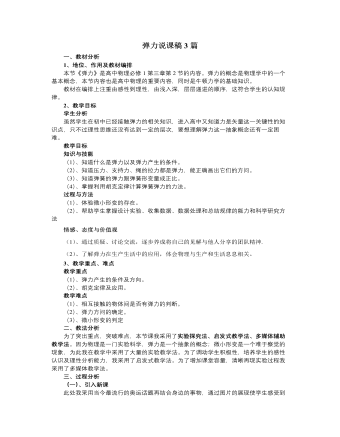
人教版新课标高中物理必修1弹力说课稿3篇
基于以上分析,为使本堂课围绕重点、突破难点,同时让学生在课堂教学中能力得到提高,我设计如下教学过程。(一)创设情景认识形变由同学们已有的形变知识入手,引入新课。教师演示:①弹簧的压缩形变;②弹簧的拉伸形变③视频播放:竹竿形变、钢丝的扭转形变。得出形变的概念及各类形变。[设计意图:我从生活情景中引入新课,是为了激发学生的好奇心,为学生学习重点和难点内容作铺垫。]设问:摩天大楼在风的吹拂下会不会摆动,发生形变吗?演示微小形变放大实验:由于这种形变不容易观察,会使学生产生疑问:到底有没有发生形变?解决的办法是微小形变的演示实验。为什么光点会往下移?让学生带着问题思考后得出结论:是由于桌面发生了形变,但是形变不明显。为后面解决压力和支持力都是弹力做好铺垫。[设计意图:使学生知道“放大”是一种科学探究的方法。]
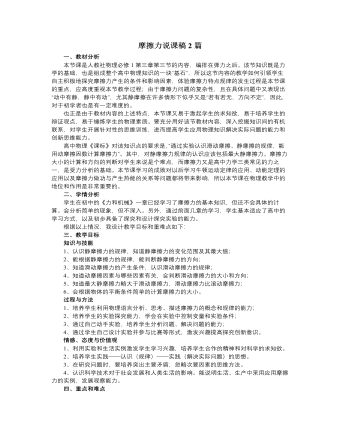
人教版新课标高中物理必修1摩擦力说课稿2篇
本节课是人教社物理必修1第三章第三节的内容,编排在弹力之后。该节知识既是力学的基础,也是组成整个高中物理知识的一块“基石”,所以这节内容的教学如何引领学生自主积极地探究摩擦力产生的条件和影响因素,体验摩擦力特点规律的发生过程是本节课的重点,应高度重视本节教学过程;由于摩擦力问题的复杂性,且在具体问题中又表现出“动中有静,静中有动”,尤其静摩擦在许多情形下似乎又是“若有若无,方向不定”,因此,对于初学者也是有一定难度的。也正是由于教材内容的上述特点,本节课又易于激起学生的求知欲,易于培养学生的辩证观点,易于锤炼学生的物理素质。要充分用好该节教材内容,深入挖掘知识间的有机联系,对学生开展针对性的思维训练,进而提高学生应用物理知识解决实际问题的能力和创新思维能力。高中物理《课标》对该知识点的要求是,“通过实验认识滑动摩擦、静摩擦的规律,能用动摩擦因数计算摩擦力”。其中,对静摩擦力规律的认识应该包括最大静摩擦力。
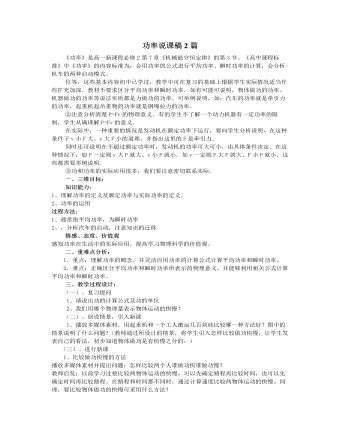
人教版新课标高中物理必修2功率说课稿2篇
(一)、复习提问1、请说出功的计算公式及功的单位2、我们用哪个物理量表示物体运动的快慢?(二)、创设情景,引入新课1、播放多媒体素材,用起重机和一个工人搬运几百块砖比较哪一种方法好?图中的情景说明了什么问题?(教师通过所设计的情景,将学生引入怎样比较做功快慢,让学生发表自己的看法,初步知道物体做功是有快慢之分的。)(三)、进行新课1、比较做功快慢的方法播放多媒体素材并提出问题:怎样比较两个人谁做功快谁做功慢?教师启发:以前学习过要比较两物体运动的快慢,可以先确定路程再比较时间,也可以先确定时间再比较路程。在路程和时间都不同时,通过计算速度比较两物体运动的快慢。同理,要比较物体做功的快慢可采用什么方法?
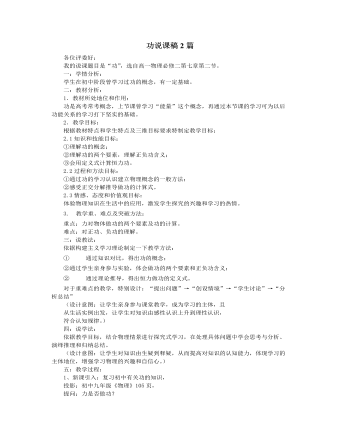
人教版新课标高中物理必修2功说课稿2篇
探究一:高中阶段功的含义是什么?投影:初中九年级《物理》105页学生思考:①图中物体的势能、动能分别如何变化?②物体能量的变化和做功是否存在关系?学生:分组讨论,得出结论:如果物体的能量发生变化时,说明有力对物体做了功。教师:进行点评和小结(设计意图:对初中知识深化理论认识,并为以后功能关系的教学作准备)探究二:力对物体做功的两个要素是什么?情景再现:找体重相对悬殊的两位同学,①A同学试图抱起B同学,但没成功。②B同学抱起A同学在教室内匀速走动。学生思考:在①中,A是否对B做功?在②中,B是否对A做功?学生:分析得出做功的两要素:物体受到力的作用,并且在力的方向上发生位移.教师:让学生分别例举生活中力对物体做功和不做功的例子,(设计意图:让学生亲身参与课堂实验,烘托课堂气氛,相互协作增进同学情谊)探究三:如果物体的位移不再力的方向上,那么力是否还对物体做功?
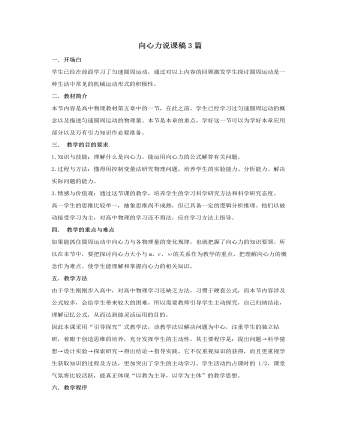
人教版新课标高中物理必修2向心力说课稿3篇
通过这个示例呢,我们可以得到解决向心力问题的一般的步骤,确定对象,找出轨迹,找出圆心,然后进行受力分析,让同学们参考这样的步骤,逐步的解决圆周运动的问题,对于变速圆周运动,我通过链球运动进行引入,这里是一个链球运动的视频,在同学们观看视频之前,我给同学们提出问题,链球收到绳子的拉力,做的是匀速圆周运动吗? 然后再课堂上我们再做一个小实验, 我们可以通过改变拉线的方式来调节小球的速度大小吗? 那么对小球,做加速圆周运动,进行受力分析,我们可以看到,小球做加速运动时,他所受到的力,并不是严格通过轨迹的圆心,在进行分析的时候,特别强调,小桶所受力的切线方向分力,和法线方向分力,切线方向分力,改变小球运动速度大小,法线方向分力,改变了小球运动的方向,法线方向的分力,在这里就是向心力,产生了向心加速度,通过这样一个例子进行分析,同学们是比较容易理解的,
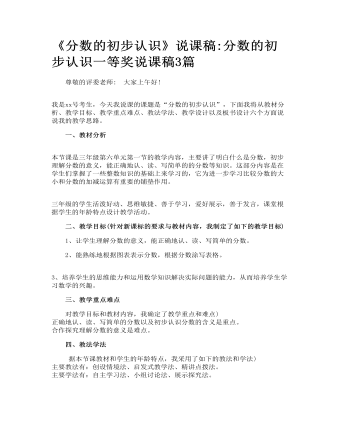
《分数的初步认识》说课稿_分数的初步认识一等奖说课稿3篇
一、教材分析? 本节课是三年级第六单元第一节的教学内容,主要讲了明白什么是分数,初步理解分数的意义,能正确地认、读、写简单的的分数等知识。这部分内容是在学生们掌握了一些整数知识的基础上来学习的,它为进一步学习比较分数的大小和分数的加减运算有重要的铺垫作用。? 三年级的学生活泼好动、思维敏捷、善于学习,爱好展示,善于发言,课堂根据学生的年龄特点设计教学活动。 二、教学目标(针对新课标的要求与教材内容,我制定了如下的教学目标)????? 1、让学生理解分数的意义,能正确地认、读、写简单的分数。????? 2、能熟练地根据图表表示分数,根据分数涂写表格。? 3、培养学生的思维能力和运用数学知识解决实际问题的能力,从而培养学生学习数学的兴趣。????? 三、教学重点难点 对教学目标和教材内容,我确定了教学重点和难点)???正确地认、读、写简单的分数以及初步认识分数的含义是重点。???合作探究理解分数的意义是难点。
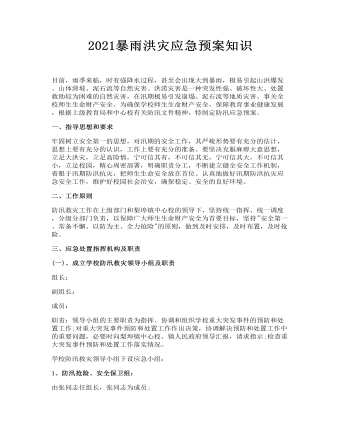
暴雨洪灾应急预案知识
一、指导思想和要求牢固树立安全第一的思想,对汛期的安全工作,其严峻形势要有充分的估计,思想上要有充分的认识,工作上要有充分的准备。要坚决克服麻痹大意思想,立足大洪灾,立足高险情,宁可信其有,不可信其无,宁可信其大,不可信其小,立足校园,精心周密部署,明确职责分工,不断建立健全安全工作机制,着眼于汛期防洪抗灾,把师生生命安全放在首位。认真地做好汛期防洪抗灾应急安全工作,维护好校园社会治安,确保稳定、安全的良好环境。二、工作原则防汛救灾工作在上级部门和梨埠镇中心校的领导下,坚持统一指挥、统一调度,分级分部门负责,以保障广大师生生命财产安全为首要目标,坚持"安全第一、常备不懈、以防为主、全力抢险"的原则,做到及时安排,及时布置,及时抢险。
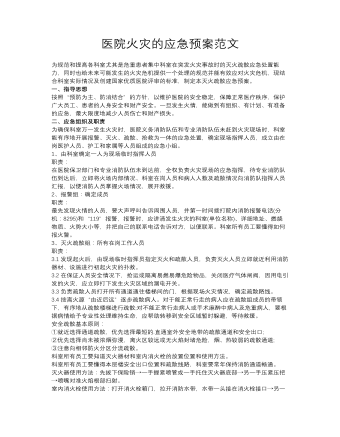
医院火灾的应急预案范文
二、应急组织及职责为确保科室万一发生火灾时,医院义务消防队伍和专业消防队伍未赶到火灾现场时,科室能有序地开展报警、灭火、疏散、抢救为一体的应急处置,确定现场指挥人员,成立由在岗医护人员、护工和家属等人员组成的应急小组。1、由科室确定一人为现场临时指挥人员职责:在医院保卫部门和专业消防队伍未到达前,全权负责火灾现场的应急指挥,待专业消防队伍到达后,立即将火场内部情况、科室在岗人员和病人人数及疏散情况向消防队指挥人员汇报,以便消防人员掌握火场情况,展开救援。
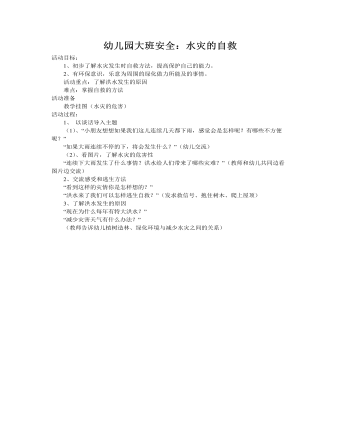
大班安全教案:水灾的自救
2、有环保意识,乐意为周围的绿化做力所能及的事情。 活动重点:了解洪水发生的原因 难点:掌握自救的方法活动准备 教学挂图(水灾的危害)活动过程:1、 以谈话导入主题 (1)、“小朋友想想如果我们这儿连续几天都下雨,感觉会是怎样呢?有哪些不方便呢?”“如果大雨连续不停的下,将会发生什么?”(幼儿交流)
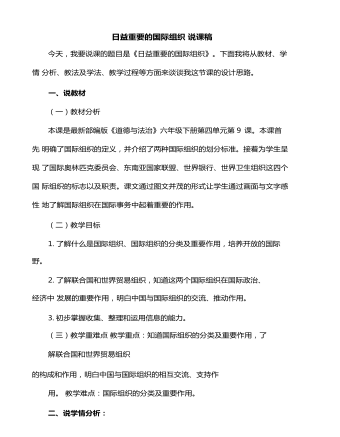
日益重要的国际组织 说课稿
一、说教材(一)教材分析本课是最新部编版《道德与法治》六年级下册第四单元第9 课。本课首先 明确了国际组织的定义,并介绍了两种国际组织的划分标准。接着为学生呈现 了国际奥林匹克委员会、东南亚国家联盟、世界银行、世界卫生组织这四个国 际组织的标志以及职责。课文通过图文并茂的形式让学生通过画面与文字感性 地了解国际组织在国际事务中起着重要的作用。(二)教学目标1. 了解什么是国际组织、国际组织的分类及重要作用,培养开放的国际视野。2. 了解联合国和世界贸易组织,知道这两个国际组织在国际政治、经济中 发展的重要作用,明白中国与国际组织的交流、推动作用。3. 初步掌握收集、整理和运用信息的能力。(三)教学重难点 教学重点:知道国际组织的分类及重要作用,了解联合国和世界贸易组织的构成和作用,明白中国与国际组织的相互交流、支持作用。 教学难点:国际组织的分类及重要作用。 二、说学情分析:从学生的学习角度上分析,在知识层面上,六年级的学生对国际组织以及 不同国际组织所处理的一些国际性事务方面的内容比较陌生,也比较遥远。相对来说,它知识性较强,趣味性不足,因此教师要努力挖掘课本知识和拓展资料,激发学生的学习兴趣,比如:布置课前预习,让学生通过网络或书籍收集 不同国际组织的资料,对国际组织有一个初步的印象;课堂学习时,抓住学生 互动学习、交流的时间,了解不同国际组织的职责以及在国际事务中发挥的巨 大作用。
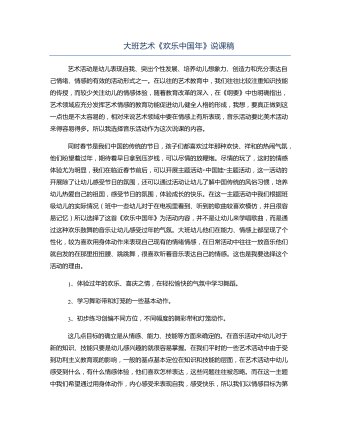
大班艺术《欢乐中国年》说课稿
同时春节是我们中国的传统的节日,孩子们都喜欢过年那种欢快、祥和的热闹气氛,他们盼望着过年,期待着早日拿到压岁钱,可以尽情的放鞭炮。尽情的玩了,这时的情感体验尤为明显,我们在临近春节前后,可以开展主题活动“中国娃”主题活动,这一活动的开展除了让幼儿感受节日的氛围,还可以通过活动让幼儿了解中国传统的风俗习惯,培养幼儿热爱自己的祖国,感受节日的氛围,体验成长的快乐。在这一主题活动中我们根据班级幼儿的实际情况(班中一些幼儿对于在电视里看到、听到的歌曲较喜欢模仿,并且很容易记忆)所以选择了这首《欢乐中国年》为活动内容,并不是让幼儿来学唱歌曲,而是通过这种欢乐鼓舞的音乐让幼儿感受过年的气氛。大班幼儿他们在能力、情感上都呈现了个性化,较为喜欢用身体动作来表现自己现有的情绪情感,在日常活动中往往一放音乐他们就自发的在那里扭扭腰、跳跳舞,很喜欢听着音乐表达自己的情感。这也是我要选择这个活动的理由。1、体验过年的欢乐、喜庆之情,在轻松愉快的气氛中学习舞蹈。2、学习舞彩带和灯笼的一些基本动作。3、初步练习创编不同方位,不同幅度的舞彩带和灯笼动作。
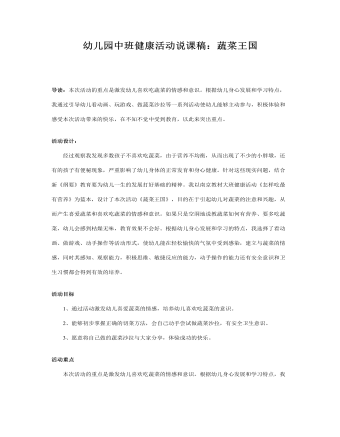
幼儿园中班健康活课稿:蔬菜王国
活动设计: 经过观察我发现多数孩子不喜欢吃蔬菜,由于营养不均衡,从而出现了不少的小胖墩,还有的孩子有便秘现象,严重影响了幼儿身体的正常发育和身心健康。针对这些现实问题,结合新《纲要》教育要为幼儿一生的发展打好基础的精神。我以南京教材大班健康活动《怎样吃最有营养》为蓝本,设计了本次活动《蔬菜王国》,目的在于引起幼儿对蔬菜的注意和兴趣,从而产生喜爱蔬菜和喜欢吃蔬菜的情感和意识。如果只是空洞地说教蔬菜如何有营养、要多吃蔬菜,幼儿会感到枯燥无味,教育效果不会好。根据幼儿身心发展和学习的特点,我选择了看动画、做游戏、动手操作等活动形式,使幼儿能在轻松愉快的气氛中受到感染,建立与蔬菜的情感,同时其感知、观察能力,积极思维、敏捷反应的能力,动手操作的能力还有安全意识和卫生习惯都会得到有效的培养。活动目标1、通过活动激发幼儿喜爱蔬菜的情感,培养幼儿喜欢吃蔬菜的意识。2、能够初步掌握正确的切菜方法,会自己动手尝试做蔬菜沙拉,有安全卫生意识。3、愿意将自己做的蔬菜沙拉与大家分享,体验成功的快乐。